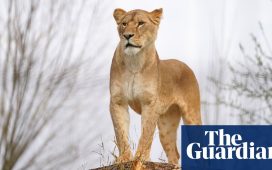
An American hunter who shot a sleeping lion, making it writhe in agony before he killed it, has sparked a global storm of repugnance, with calls for him to be hunted down himself to face justice.
Footage of Guy Gorney shooting the animal in Zimbabwe has gone viral on social media, prompting universal fury.
Some users said they would love him to be savaged by lions, others said they would enjoy attacking him, and some hoped he too died in agony.
We’ll tell you what’s true. You can form your own view.
From
15p
€0.18
$0.18
USD 0.27
a day, more exclusives, analysis and extras.
The video, dating back to 2011, shows Mr Gorney being coached in shooting. He points his rifle at the sleeping lion and fires a shot, which awakes the animal.
It arches its back in pain and writhes on its back, unable to stand or run away.
1/12 113809428.jpg
The International Union for Conservation of Nature says the Western Black Rhino (pictured) is extinct and two other species of rhino are “possibly” extinct.
Getty Images
2/12 Reef Manta Ray_Manta alfredi_Andrea Marshall.JPG
The Reef Manta Ray is also on the conservation group’s Red List of Threatened Species.
3/12 Southern White Rhino subspecies _Ceratotherium simum simum_Dr Richard Emslie (2).JPG
The Southern White Rhino of central Africa is now “possibly extinct” in the wild and firmly placed on the Red List of Threatened Species.
4/12 Summers Poison Frog_Ranitomeya summers_Jason Brown.jpg
The Blessed Poison Frog (Ranitomeya benedicta) is currently listed as Vulnerable and the Summers’ Poison Frog (pictured) (Ranitomeya summersi) is Endangered.
5/12 Tarzans Chameleon_ Calumma tarzan_Jörn Köhler.jpg
The current Red List reveals that an alarming 40% of Madagascar’s terrestrial reptiles are threatened. The 22 Madagascan species currently identified as Critically Endangered, which include chameleons, geckoes, skinks and snakes, are now a conservation challenge.
Encouragingly, there are new conservation areas being designated in Madagascar that will help conserve a significant proportion of Critically Endangered species, such as Tarzan’s Chameleon (Calumma tarzan) (pictured), the Bizarre-nosed Chameleon (Calumma hafahafa) and the Limbless Skink (Paracontias fasika).
6/12 Paroedura masobe_Franco Andreone.jpg
The Paroedura masobe gecko is classed as “endangered” by the IUCN.
7/12 Giant Manta Ray_Manta birostris_Andrea Marshall.jpg
Giant Manta Ray (Manta birostris), the largest species of rays, is also on the conservation group’s Red List of Threatened Species and classed as “vulnerable”.
8/12 Coco der Mer_Lodoicea maldivica_Jean-Christophe Vie (2).JPG
The majority of endemic flowering plants in the granitic Seychelles islands have been assessed and current studies show that of the 79 endemic species, 77% are at risk of extinction. Most of these are new assessments but one species, the infamous Coco de Mer (Lodoicea maldivica) has been uplisted from Vulnerable to Endangered. Known for its supposed aphrodisiac properties, the Coco de Mer faces threats from fires and illegal harvesting of its kernels.
9/12 Chinese Water Fir_Glyptostrobus pensilis_Philip Thomas.jpg
The Chinese Water Fir (Glyptostrobus pensilis), which was formerly widespread throughout China and Viet Nam, has been upgraded from Endangered to Critically Endangered.
10/12 Begonia seychellensis_Justin Gerlach.JPG
The Begonia seychellensis is one of the many tropical plant species at risk.
11/12 The Blessed Poison Frog_Ranitomeya benedicta_Jason Brown (1).jpg
The Blessed Poison Frog (Ranitomeya benedicta) is currently listed as Vulnerable.
12/12 Przewalski’s Horse_ Equus ferus_Patricia D Moehlman.jpg
The Przewalski’s Horse (Equus ferus) is another success story, improving its status from Critically Endangered to Endangered.
1/12 113809428.jpg
The International Union for Conservation of Nature says the Western Black Rhino (pictured) is extinct and two other species of rhino are “possibly” extinct.
Getty Images
2/12 Reef Manta Ray_Manta alfredi_Andrea Marshall.JPG
The Reef Manta Ray is also on the conservation group’s Red List of Threatened Species.
3/12 Southern White Rhino subspecies _Ceratotherium simum simum_Dr Richard Emslie (2).JPG
The Southern White Rhino of central Africa is now “possibly extinct” in the wild and firmly placed on the Red List of Threatened Species.
4/12 Summers Poison Frog_Ranitomeya summers_Jason Brown.jpg
The Blessed Poison Frog (Ranitomeya benedicta) is currently listed as Vulnerable and the Summers’ Poison Frog (pictured) (Ranitomeya summersi) is Endangered.
5/12 Tarzans Chameleon_ Calumma tarzan_Jörn Köhler.jpg
The current Red List reveals that an alarming 40% of Madagascar’s terrestrial reptiles are threatened. The 22 Madagascan species currently identified as Critically Endangered, which include chameleons, geckoes, skinks and snakes, are now a conservation challenge.
Encouragingly, there are new conservation areas being designated in Madagascar that will help conserve a significant proportion of Critically Endangered species, such as Tarzan’s Chameleon (Calumma tarzan) (pictured), the Bizarre-nosed Chameleon (Calumma hafahafa) and the Limbless Skink (Paracontias fasika).
6/12 Paroedura masobe_Franco Andreone.jpg
The Paroedura masobe gecko is classed as “endangered” by the IUCN.
7/12 Giant Manta Ray_Manta birostris_Andrea Marshall.jpg
Giant Manta Ray (Manta birostris), the largest species of rays, is also on the conservation group’s Red List of Threatened Species and classed as “vulnerable”.
8/12 Coco der Mer_Lodoicea maldivica_Jean-Christophe Vie (2).JPG
The majority of endemic flowering plants in the granitic Seychelles islands have been assessed and current studies show that of the 79 endemic species, 77% are at risk of extinction. Most of these are new assessments but one species, the infamous Coco de Mer (Lodoicea maldivica) has been uplisted from Vulnerable to Endangered. Known for its supposed aphrodisiac properties, the Coco de Mer faces threats from fires and illegal harvesting of its kernels.
9/12 Chinese Water Fir_Glyptostrobus pensilis_Philip Thomas.jpg
The Chinese Water Fir (Glyptostrobus pensilis), which was formerly widespread throughout China and Viet Nam, has been upgraded from Endangered to Critically Endangered.
10/12 Begonia seychellensis_Justin Gerlach.JPG
The Begonia seychellensis is one of the many tropical plant species at risk.
11/12 The Blessed Poison Frog_Ranitomeya benedicta_Jason Brown (1).jpg
The Blessed Poison Frog (Ranitomeya benedicta) is currently listed as Vulnerable.
12/12 Przewalski’s Horse_ Equus ferus_Patricia D Moehlman.jpg
The Przewalski’s Horse (Equus ferus) is another success story, improving its status from Critically Endangered to Endangered.
Mr Gorney fires twice more before the guide intervenes and shakes his hand to congratulate him.
The guide says: “A very nice lion,” laughs and pats Mr Gorney on the back.
The footage also shows the pair prodding the dead lion with the rifle and admiring it, before the guide shakes Mr Gorney’s hand again.
One Twitter user described him as a “gutless self-obsessed narcissist with a gun, overactive ego and far too much money to waste”.
Another, Silvio Pires, wrote: “Can anyone explain to me how this monster is walking freely amongst us?! Pity our society when we allow such barbaric [sic] not to be punished!”
Colin Mckillen said: “No words for what this evil b*****d gets up to. Let’s hope karma catches up with him – he really deserves the worst.”
“Trophy” hunting is legal in Zimbabwe and South Africa, where wealthy hunters – usually American – pay huge sums to shoot animals dead.
Africa’s lion populations have plummeted in recent years, with estimates there could be as few as 15,000 left.
Mr Gorney, 65, from Manhattan, Illinois, has not responded to any of the torrent of criticism.
His Facebook account – where his profile picture shows him straddling another lion he killed – is not visible, and that of a woman apparently his daughter is also not public.
He has not responded to media requests to comment.
He has previously admitted having killed the “big five” species: elephant, lion, leopard, rhino and buffalo.
In 2015 he told WBBM radio he had killed 70 animals.
“I like pitting myself against these animals. And what greater trophy than an elephant?” he said.
He claimed hunting was conservation. “You can say, why’d you shoot a lion? I love zebra, so shooting a lion probably saves 70 zebra a year, give or take,” he said.
He said he follows the law when hunting and can’t abide poachers.
The US allows hunters with permits to import wildlife “trophies”.
In the UK, Lion Aid is lobbying for a ban on imports of lion parts to discourage hunting.
We’ll tell you what’s true. You can form your own view.
At The Independent, no one tells us what to write. That’s why, in an era of political lies and Brexit bias, more readers are turning to an independent source. Subscribe from just 15p a day for extra exclusives, events and ebooks – all with no ads.













